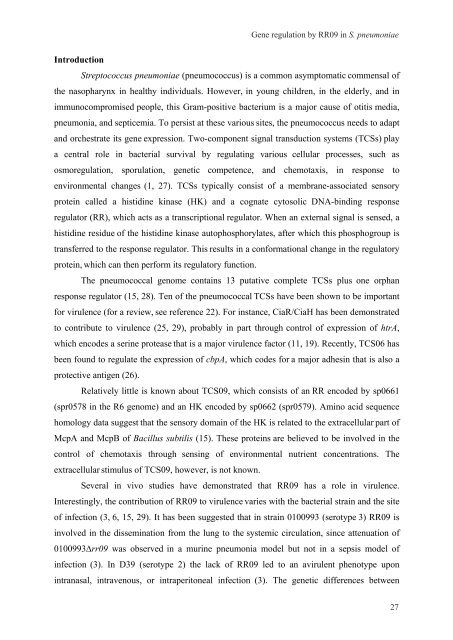Gene regulation in Streptococcus pneumoniae - RePub - Erasmus ...
Gene regulation in Streptococcus pneumoniae - RePub - Erasmus ...
Gene regulation in Streptococcus pneumoniae - RePub - Erasmus ...
Create successful ePaper yourself
Turn your PDF publications into a flip-book with our unique Google optimized e-Paper software.
Introduction<br />
<strong>Streptococcus</strong> <strong>pneumoniae</strong> (pneumococcus) is a common asymptomatic commensal of<br />
the nasopharynx <strong>in</strong> healthy <strong>in</strong>dividuals. However, <strong>in</strong> young children, <strong>in</strong> the elderly, and <strong>in</strong><br />
immunocompromised people, this Gram-positive bacterium is a major cause of otitis media,<br />
pneumonia, and septicemia. To persist at these various sites, the pneumococcus needs to adapt<br />
and orchestrate its gene expression. Two-component signal transduction systems (TCSs) play<br />
a central role <strong>in</strong> bacterial survival by regulat<strong>in</strong>g various cellular processes, such as<br />
osmo<strong>regulation</strong>, sporulation, genetic competence, and chemotaxis, <strong>in</strong> response to<br />
environmental changes (1, 27). TCSs typically consist of a membrane-associated sensory<br />
prote<strong>in</strong> called a histid<strong>in</strong>e k<strong>in</strong>ase (HK) and a cognate cytosolic DNA-b<strong>in</strong>d<strong>in</strong>g response<br />
regulator (RR), which acts as a transcriptional regulator. When an external signal is sensed, a<br />
histid<strong>in</strong>e residue of the histid<strong>in</strong>e k<strong>in</strong>ase autophosphorylates, after which this phosphogroup is<br />
transferred to the response regulator. This results <strong>in</strong> a conformational change <strong>in</strong> the regulatory<br />
prote<strong>in</strong>, which can then perform its regulatory function.<br />
The pneumococcal genome conta<strong>in</strong>s 13 putative complete TCSs plus one orphan<br />
response regulator (15, 28). Ten of the pneumococcal TCSs have been shown to be important<br />
for virulence (for a review, see reference 22). For <strong>in</strong>stance, CiaR/CiaH has been demonstrated<br />
to contribute to virulence (25, 29), probably <strong>in</strong> part through control of expression of htrA,<br />
which encodes a ser<strong>in</strong>e protease that is a major virulence factor (11, 19). Recently, TCS06 has<br />
been found to regulate the expression of cbpA, which codes for a major adhes<strong>in</strong> that is also a<br />
protective antigen (26).<br />
Relatively little is known about TCS09, which consists of an RR encoded by sp0661<br />
(spr0578 <strong>in</strong> the R6 genome) and an HK encoded by sp0662 (spr0579). Am<strong>in</strong>o acid sequence<br />
homology data suggest that the sensory doma<strong>in</strong> of the HK is related to the extracellular part of<br />
McpA and McpB of Bacillus subtilis (15). These prote<strong>in</strong>s are believed to be <strong>in</strong>volved <strong>in</strong> the<br />
control of chemotaxis through sens<strong>in</strong>g of environmental nutrient concentrations. The<br />
extracellular stimulus of TCS09, however, is not known.<br />
<strong>Gene</strong> <strong>regulation</strong> by RR09 <strong>in</strong> S. <strong>pneumoniae</strong><br />
Several <strong>in</strong> vivo studies have demonstrated that RR09 has a role <strong>in</strong> virulence.<br />
Interest<strong>in</strong>gly, the contribution of RR09 to virulence varies with the bacterial stra<strong>in</strong> and the site<br />
of <strong>in</strong>fection (3, 6, 15, 29). It has been suggested that <strong>in</strong> stra<strong>in</strong> 0100993 (serotype 3) RR09 is<br />
<strong>in</strong>volved <strong>in</strong> the dissem<strong>in</strong>ation from the lung to the systemic circulation, s<strong>in</strong>ce attenuation of<br />
0100993∆rr09 was observed <strong>in</strong> a mur<strong>in</strong>e pneumonia model but not <strong>in</strong> a sepsis model of<br />
<strong>in</strong>fection (3). In D39 (serotype 2) the lack of RR09 led to an avirulent phenotype upon<br />
<strong>in</strong>tranasal, <strong>in</strong>travenous, or <strong>in</strong>traperitoneal <strong>in</strong>fection (3). The genetic differences between<br />
27<br />
27

















